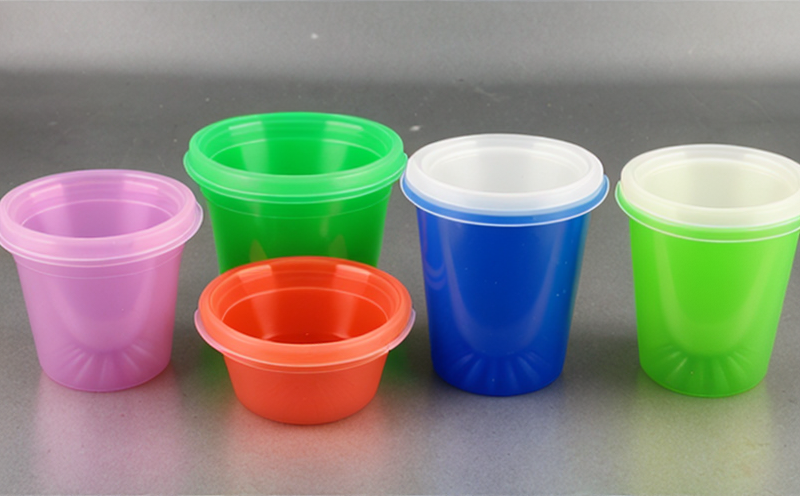BS EN ISO 16000 VOC Emission Testing of Disposable Plastics
The testing of volatile organic compounds (VOCs) from disposable plastics is a critical step in ensuring the safety and regulatory compliance of products across various sectors such as healthcare, food packaging, and consumer goods. This service focuses on the BS EN ISO 16000 series of standards, which provide guidelines for determining VOC emissions from materials used in the production of disposable plastics.
Understanding the importance of VOCs is essential because they are chemical compounds that evaporate at room temperature. These compounds can be harmful to human health and the environment if not properly controlled during manufacturing processes. The BS EN ISO 16000 series aims to address these concerns by offering stringent methods for measuring volatile emissions, ensuring that products meet strict environmental and safety standards.
The testing process involves several critical steps. Initially, samples are prepared according to specific protocols outlined in the standard. This may include cutting specimens into uniform sizes or shapes suitable for analysis. Once prepared, the specimens undergo rigorous testing using specialized equipment designed to simulate real-world conditions under which they will be used.
One of the key pieces of instrumentation used during this test is a gas chromatograph equipped with an appropriate detector capable of identifying and quantifying various VOCs present in the sample. The equipment must adhere strictly to international standards such as ISO 6803, ensuring accurate results. After collecting data from the analysis, it’s important to compare these findings against established thresholds set forth by relevant regulations like OSHA or EU legislation.
The outcome of this testing not only helps manufacturers ensure their products meet regulatory requirements but also provides valuable insights into potential improvements that could enhance both performance and sustainability aspects of their offerings. By identifying problematic areas early in the development phase, companies can implement corrective measures before launching final versions to market.
Compliance with these standards is crucial for businesses operating internationally or those dealing with stringent local regulations concerning emissions from plastic products. Failure to comply can result in costly fines and damage to brand reputation due to public perception issues surrounding environmental responsibility.
In conclusion, conducting BS EN ISO 16000 VOC emission testing ensures that disposable plastics produced are safe for end-users while maintaining compliance with global standards. This service plays a vital role in safeguarding human health and protecting our environment from harmful pollutants released during the lifecycle of these materials.
Applied Standards
The BS EN ISO 16000 series encompasses several documents that are integral to various aspects of VOC emission testing. These include:
| Standard Number | Description |
| BS EN ISO 16000-3:2018 | Method for Determining Volatile Organic Compounds (VOCs) from Materials Used in the Production of Disposable Plastics |
| BS EN ISO 16000-9:2015 | Guidelines on Sampling and Sample Preparation for VOC Emissions Testing |
| BS EN ISO 16000-84:2017 | Method for Determining Volatile Organic Compounds (VOCs) from Materials Used in the Production of Disposable Plastics by Gas Chromatography-Mass Spectrometry (GC-MS) |
| BS EN ISO 16000-85:2017 | Method for Determining Volatile Organic Compounds (VOCs) from Materials Used in the Production of Disposable Plastics by Gas Chromatography-Fourier Transform Infrared Spectroscopy (GC-FTIR) |
These standards provide comprehensive guidance on how to perform VOC emission testing, ensuring accurate and reliable results. Compliance with these internationally recognized guidelines is essential for maintaining high-quality standards in the production of disposable plastics.
Competitive Advantage and Market Impact
Conducting VOC emission tests according to BS EN ISO 16000-3 offers significant competitive advantages and market impacts. Firstly, it demonstrates a company's commitment to sustainability and environmental responsibility, which is increasingly important for consumers who are becoming more environmentally conscious.
By adhering to these rigorous testing protocols, manufacturers can ensure that their products meet or exceed regulatory requirements, thereby avoiding costly penalties and potential legal disputes. This compliance also enhances brand reputation, making it easier to gain trust from customers and stakeholders.
In terms of market positioning, companies that invest in VOC emission testing according to BS EN ISO 16000-3 may find themselves better positioned against competitors who do not prioritize similar measures. It allows firms to differentiate their offerings based on superior product quality and safety features, potentially leading to higher sales volumes and customer loyalty.
Moreover, this service can contribute to broader industry initiatives aimed at reducing environmental impact through responsible manufacturing practices. By setting a benchmark for VOC emissions in disposable plastics, it encourages others within the sector to follow suit, fostering innovation and improvement throughout the entire supply chain.
In summary, implementing VOC emission testing according to BS EN ISO 16000-3 not only ensures regulatory compliance but also provides tangible benefits that can enhance a company's competitive edge in today’s marketplaces.





